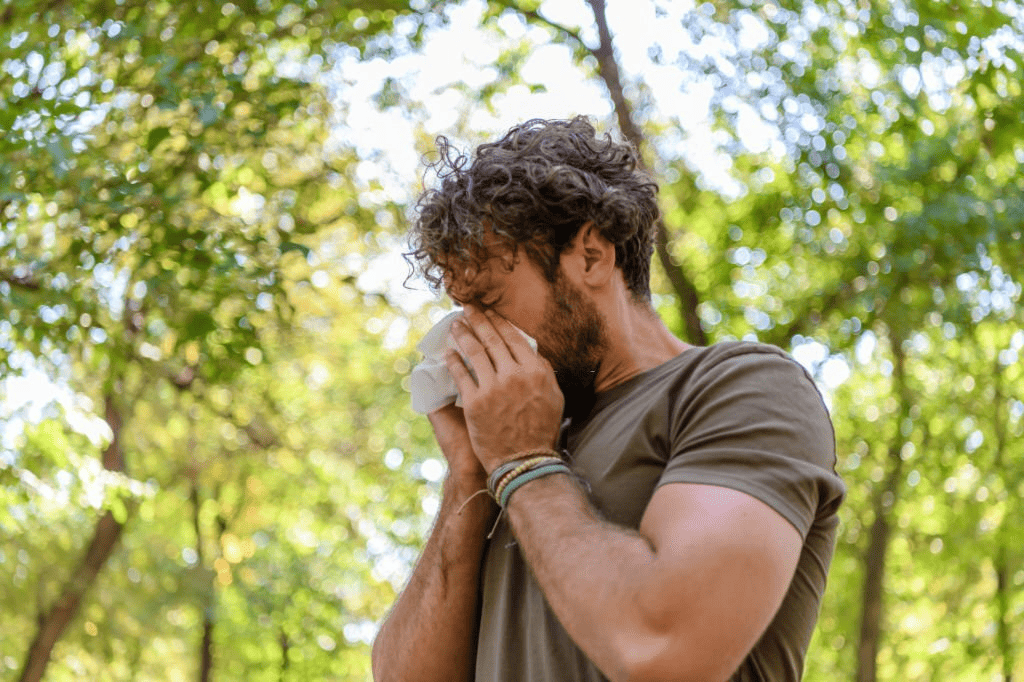
In the upper latitudes of the northern hemisphere, the period beginning with the onset of spring and leading up to the end of the summer season is seen as a blessing, providing great comfort from the chills and despondency of long winters.
This period also coincides with seasonal allergic rhinitis, commonly known as hay fever.
The warm weather conditions are ideal for a party, but the cozy outdoor environment also brings us into contact with all kinds of pollen, especially grass pollen, which causes hay fever.
What is hay fever?
When one’s body is exposed to pollen, it triggers an auto-immune response from the body, causing the release of antibodies called immunoglobulin E (IgE), which, in turn, releases a substance called histamine in the body. It is histamine that causes the typical symptoms of Hay Fever.
While hay fever can be caused by a variety of tree and weed pollens, it is grass pollen that is responsible for the bulk of the cases.
What is pollen
Pollen is a fine to coarse powdery substance created by certain plants as part of their reproduction process. It can appear in trees in the spring, grasses in the summer, and weeds in the fall.
Since pollen is very fine and powdery, it is easily transferred by wind. This mechanism of transmission has been adopted by most trees, grasses, and weeds to propagate their populations, which makes pollen easily enter our noses, eyes, and throats and create havoc for those allergic to it.
Unlike the pollen of trees, grasses, and weeds, the pollen released by flowers is not that light and dusty, as a result of the hay fever that commonly occurs.
Hay fever prevalence
Hay fever is entirely non-discriminatory, as it affects people of all ages and genders. Though some suffer from it almost for their entire life, for others, it may develop later in life and occur on and off.
In the United Kingdom, as per the Met Department study, 1 in 5 people suffer from hay fever every year, mostly between the months of February and August. Hay fever continues to cause trouble as long as the pollen one is allergic to remains prevalent.
One is not typically allergic to all types of pollen. That is the reason why we do not suffer from hay fever unless exposed to the pollen we are specifically allergic to.
Instances of hay fever are on the rise due to climate change, as warmer and windier weather helps pollen travel farther and remain in the air longer. Increasing air pollution is also a leading cause.
Some have hypothesized that a more hygienic lifestyle, especially in the early childhood years, reduces our exposure to bacteria and allergens, which in a way impedes our immunity and makes us more susceptible to such conditions in later years.
How is an allergy to pollen diagnosed?
Doctors typically rely on skin prick tests to diagnose which pollen you are allergic to. In this, the specialist doctor draws a grid on your arm and places a drop of allergy specific liquid into each of the squares.
Thereafter, the doctor pricks the skin in each square to let the liquid enter our bloodstream. The allergen one is allergic to will cause the skin to turn itchy with a red bump, which confirms the susceptibility to that allergen.
A specific IgE blood test, or allergy testing, is another mechanism to establish your pollen allergy.
Typical symptoms of hay fever
Those suffering from hay fever report some or all of the following symptoms:
- Frequent sneezing
- Choked nose
- Running nose
- Loss of smell
- Itchy, watery, red eyes
- An itchy throat or itching in the ears or roof of the mouth
- A post-nasal drip, where a runny nose drips back down into the throat which cause coughing
- Headache caused by blocked sinuses
- Tiredness
Medical treatment for hay fever
Since the antibodies generated in response to pollen entering our bodies lead to the release of histamine, antihistamines are prescribed to deal with the symptoms of hay fever. Most of the antihistamine tablets, nasal sprays, and eye drops could be bought over the counter.
The next best treatments are corticosteroids. They help reduce inflammation and swelling in the nasal passages, but they should be started about 2 weeks before the onset to be effective.
Sublingual Immunotherapy as a Treatment Option
Sublingual immunotherapy (SLIT) is a treatment to reduce sensitivity to allergens. It is given orally and can take 3-5 years, with effects lasting up to 10 years. Safe for asthma and rhinitis patients, SLIT is recognized as a good alternative to conventional treatment.
Based on 40+ clinical trials and meta-analyses, SLIT is recommended as it has a favourable safety profile, even for children.
Other tips to deal with hay fever
There are practical ways through which we could minimize instances of hay fever:
- Plan outdoor trips when pollen is at the lowest level, i.e. early morning or post rainfall.
- Avoid freshly cut grasses and forest areas.
- Keep the car windows up while driving.
- Take a shower after coming from outside.
- Wash clothes more often.
- Keep home free from dust.
- Use air purifiers and air humidifiers.
In a Nutshell
In conclusion, managing hay fever allergies is all about taking the right steps. This includes allergy testing, sublingual immunotherapy, and avoiding triggers.
With the right strategy, you can enjoy the warm weather without having to suffer from the symptoms of hay fever. For those residing in London and seeking allergy testing, please feel free to make an appointment with our allergist in London for a full consultation.
